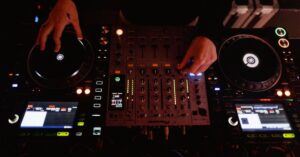What is the Pareto Principle?
The Pareto Principle is rooted in the observation that 80% of outcomes often come from 20% of causes. Initially, Vilfredo Pareto applied this to economics, noticing that 80% of the wealth in Italy was controlled by 20% of the population. However, over time, this idea has proven to be applicable to almost everything – from business to fitness to creativity.
In essence, the principle suggests that most of your efforts, whether in life or work, produce only a small portion of the results. The flip side is that a small number of focused, high-impact actions yield the majority of your outcomes. This concept is so versatile that we can apply it to almost every aspect of life – and music production is no exception. Let me give you a few examples.
How does the Pareto Principle apply to music production? 1
In music production, the 80/20 rule helps you recognise which parts of your workflow are contributing most to the success of your tracks. The reality is, 80% of the time we spend producing is often filled with tasks that don’t actually improve the final product. Instead, 20% of your efforts – the focused, high-impact tasks – are responsible for most of the progress you make. For example: if you spend the whole day sound designing the lead synth of a great 8 bar loop you’re working on, this is most likely the 20%. Whereas doing the arrangement and arranging the loop to a full track would be the 80% that get you closer to a finished track than the sound design of the synth line.
One of the most common challenges for producers is information overload. With countless tutorials, courses, and opinions on how to create music, it’s easy to get lost in a sea of advice without actually doing much. This is especially true when it comes to finding the “perfect” synth or plugin – you could spend weeks researching and downloading without making any real progress on a track.
Information overload: The productivity killer
The truth is, 80% of the information you consume may not even be useful for your music-making process. It might be interesting or informative, but if you’re not going to put that knowledge to use immediately, it’s likely just a distraction. The Pareto Principle encourages you to focus on the 20% of information that directly contributes to your progress as a producer.
Instead of diving into endless forums or tutorials, ask yourself:
- Will this information help me finish the track I’m working on right now?
- Am I spending too much time looking for answers when I could be honing my production skills instead.
Streamlining your production process
Another way the Pareto Principle can revolutionise your production workflow is by helping you focus on fewer, more impactful choices. This is especially true when it comes to selecting sounds, plugins, and synths. Instead of spending hours auditioning every sample or preset, streamline your choices.
Sound selection: Less is more
Let’s say you’re starting a new track. Do you spend hours cycling through hundreds of drum samples, or do you go to a pre-selected list of trusted sounds? The latter will save you time and reduce creative block.
By using a pre-made library of your favorite sounds, you can reduce decision fatigue and focus more on the creative process. Narrowing down your options might feel limiting at first, but in reality, it helps you concentrate on what really matters – finishing your track!
The 80/20 rule in sound design and mixing
When it comes to sound design and mixing, the Pareto Principle can be applied just as effectively. Often, producers spend a disproportionate amount of time tweaking minor details that won’t make a noticeable difference in the final product. Instead, focusing on the 20% of elements that have the biggest impact will move your track much closer to the finish line.
Sound design: Focusing on the core elements
While it’s tempting to spend hours creating intricate, layered sounds, remember that the foundation of your track is what truly matters. In most tracks, the drums, and lead elements do the heavy lifting. These are the elements that grab the listener’s attention and define the vibe of your track. By concentrating 80% of your energy on nailing these core elements, you’ll make much more progress in a shorter amount of time.
For example, if you’re producing a techno track, focus on dialling in a solid theme or motive and some drums, finding a groove that drives the track. Once these primary elements are in place, you can add the subtler sounds, textures, and effects to enhance the track – but don’t let the details distract you from the main goal.
Mixing: Don’t overcomplicate it
The same principle applies to mixing. Rather than spending countless hours obsessing over tiny EQ adjustments on a hi-hat, focus on the broader strokes that will have the most impact. Start with the levels and balance – get the volume of your key elements sitting well together. Once the foundation of your mix is solid, you can make the necessary adjustments to polish it further.
In practice, this means the 20% of your mixing efforts that will yield 80% of the mix results come down to volume and balance. These two factors form the foundation of a great mix. If your volumes and balancing are on point, you’ve already taken care of the majority of the work.
Once you have the right balance, the remaining mix tweaks – like compression limiting and EQing – are simply there to smooth out peaks and add subtle control. However, no amount of compression or limiting can fix a mix if your volumes are off and the balance is not well thought out. That’s why it’s crucial to spend the bulk of your time in the early stages making sure everything is sitting right in the mix. Once that’s done, the rest is just fine-tuning.
Maximising creativity with minimal distractions
Creativity thrives on focus and flow, yet in the age of endless options and constant distractions, it’s easy to fall into the trap of overthinking and procrastination. Here, the Pareto Principle can help you maximise your creative output by eliminating unnecessary distractions and focusing on the essentials.
Time-sucks to avoid
By identifying and cutting out the habits and tasks that waste time, you can free up more hours for productive music-making:
- Excessive Social Media and Email Checking: Spending hours scrolling through social media or checking emails multiple times a day eats into your music production time.
- Procrastinating and Non-Essential Tasks: Whether in music production or daily life, it’s easy to fall into the trap of procrastination by focusing on non-essential tasks. These can be distractions like organising files, cleaning your workspace, or endlessly tweaking small details.
Limiting your toolset
As producers, we often fall victim to “plugin paralysis” – the overwhelming feeling of having too many options when it comes to synths, effects, and samples. The truth is, 80% of the music you create could be made using just 20% of the tools you already have.
By simplifying your toolset and mastering a select few synths and effects, you not only speed up your workflow but also develop a deeper understanding of your tools. This allows you to get the sound you want faster, without the need for constant experimentation or second-guessing.
Creating an efficient workflow
Another powerful way to apply the Pareto Principle is by building a reliable workflow. This could involve setting up templates in your DAW, organising your sample library, or developing a structured routine for how you approach the production workflow. One efficient approach is to divide the production process into a creative phase and an editing phase, rather than aiming to complete the track all at once from the outset. If you’re interested in learning more about this concept, check out my blog post on workflow optimisation.
Having these systems in place allows you to focus on the key aspects of production, rather than wasting time on repetitive setup tasks.
For example:
- Templates: Use project templates that already have your go-to sounds, groups, and effects loaded up. This way, you can jump straight into creating rather than starting from scratch every time.
- Pre-selected Samples: Organise your sample library into “go to” folders, so you can quickly access the sounds you know work for your style.
- Structured Routine: Create a workflow that is as productive as possible by clearly separating the creative and editing phases for example. This approach minimises decision fatigue and allows you to stay fully focused on the task at hand.







